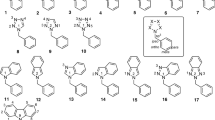Conclusions
-
1.
13C and1H NMR has been used in investigating the structure of azacations. It has been found that the cations exist in the form of Immonium salts, and the contribution of the limiting structure, which is an aminocarbonium ion, is small. The cations of the protonated imines have mainly the trans configuration.
-
2.
The presence of aryl substituents leads to partial delocalization of plus charge from the N=C bond onto the aromatic rings bonded to the N atom and/or to the methylene C atom.
-
3.
A determination has been made of β-Isotope effects on\(\delta ^{13} C\mathop N\limits^ + = C\) and\(---C---\mathop N\limits^ + = \) carbons: the deuterium isotope shift of carbon resonance corresponds to an increase in screening of the carbon nuclei.
Similar content being viewed by others
Literature cited
G. A. Olah and P. Kreienbahl, J. Am. Chem. Soc.,89, 756 (1967).
G. A. Olah, A. M. White, and D. H. O'Brien, Chem. Rev.,70, 561 (1970).
Carbonium Ions, Vol. 4, Wiley-Interscience, New York (1973), p. 1656.
J. B. Stothers, Organic Chemistry, Vol. 24, Academic Press, New York (1972), pp. 70, 81.
U. Vogeli and W. Von Phillipsborn, Org. Magn. Reson.,7, 617 (1975).
G. Miyajima, K. Takahashi, and K. Nishimoto, Org. Magn. Reson.,6, 413 (1974).
G. J. Ray, R. J. Kurland, and A. K. Colter, Tetrahedron,27, 735 (1971).
V. S. Bogdanov, A. S. Gybin, V. A. Smit, et al., Izv. Akad. Nauk SSSR, Ser. Khim., 2681 (1981).
E. G. Cherepanova, V. S. Bogdanov, Yu. V. Kal'yan, et al., Izv. Akad. Nauk SSSR, Ser. Khim., 1531 (1982).
G. A. Olah, P. W. Westerman, and D. A. Forsyth, J. Am. Chem. Soc.,97, 3419 (1975).
G. C. Levy and G. L. Nelson, Carbon-13 Nuclear Magnetic Resonance for Organic Chemists, Wiley-Interscience, New York (1972).
K. Laidler, Kinetics of Organic Reactions [Russian translation], Mir, Moscow (1966).
Weygand and G. Hilgetag, Experimental Methods in Organic Chemistry [Russian translation, edited by N. N. Suvorov], Khimiya, Moscow (1968), p. 470.
J. F. Walker, Formaldehyde, 2nd ed., Reinhold, New York (1953).
G. Martin and M. Martin, Bull. Soc. Chim. Fr., 1637 (1963).
Author information
Authors and Affiliations
Additional information
Translated from Izvestiya Akademii Nauk SSSR, Seriya Khimicheskaya, No. 9, pp. 1974–1979, September, 1987.
Rights and permissions
About this article
Cite this article
Bogdanov, V.S., Krylov, S.S., Shvedova, S.N. et al. Investigation of structure of immonium salts by means of13C and1H NMR spectrometry. Russ Chem Bull 36, 1829–1834 (1987). https://doi.org/10.1007/BF00958323
Received:
Issue Date:
DOI: https://doi.org/10.1007/BF00958323




